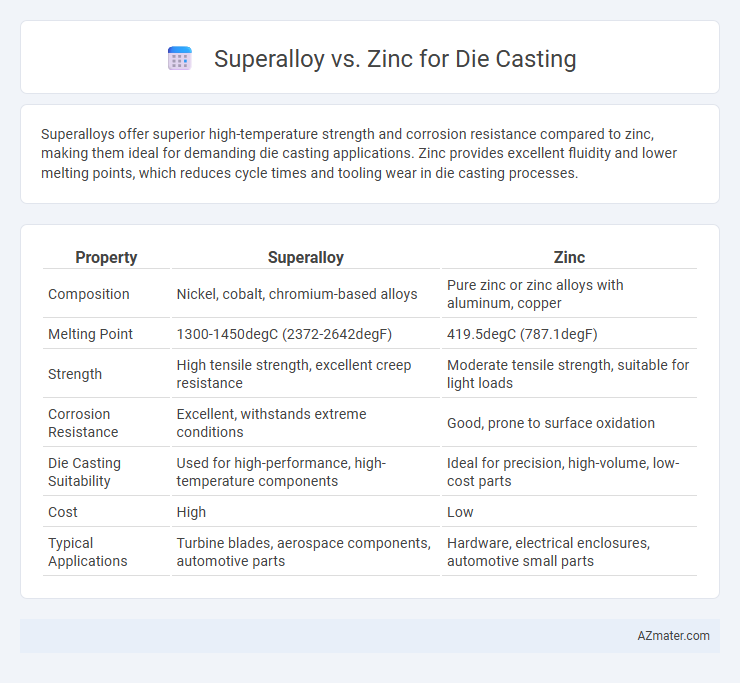Superalloys offer superior high-temperature strength and corrosion resistance compared to zinc, making them ideal for demanding die casting applications. Zinc provides excellent fluidity and lower melting points, which reduces cycle times and tooling wear in die casting processes.
Table of Comparison
| Property | Superalloy | Zinc |
|---|---|---|
| Composition | Nickel, cobalt, chromium-based alloys | Pure zinc or zinc alloys with aluminum, copper |
| Melting Point | 1300-1450degC (2372-2642degF) | 419.5degC (787.1degF) |
| Strength | High tensile strength, excellent creep resistance | Moderate tensile strength, suitable for light loads |
| Corrosion Resistance | Excellent, withstands extreme conditions | Good, prone to surface oxidation |
| Die Casting Suitability | Used for high-performance, high-temperature components | Ideal for precision, high-volume, low-cost parts |
| Cost | High | Low |
| Typical Applications | Turbine blades, aerospace components, automotive parts | Hardware, electrical enclosures, automotive small parts |
Introduction to Die Casting Materials
Superalloys and zinc are prominent materials in die casting, each offering distinct advantages depending on application requirements. Superalloys provide exceptional high-temperature strength, corrosion resistance, and durability, making them ideal for aerospace and automotive parts subjected to extreme conditions. Zinc excels in low melting point, excellent fluidity, and cost-effectiveness, favored for complex, high-precision components in consumer electronics and hardware industries.
Overview of Superalloys in Die Casting
Superalloys in die casting offer exceptional high-temperature strength, corrosion resistance, and durability, making them ideal for aerospace and automotive applications requiring superior mechanical performance. Unlike zinc, which provides excellent fluidity and low melting points for cost-effective production, superalloys require specialized high-temperature casting processes due to their complex compositions and alloying elements like nickel, cobalt, and chromium. The use of superalloys enhances component lifespan and reliability under extreme operational stresses but demands advanced die casting techniques to manage their higher melting temperatures and prevent defects.
Zinc Alloys: Properties and Uses
Zinc alloys exhibit excellent die casting characteristics, such as low melting points between 380-420degC, high fluidity, and rapid solidification, making them ideal for complex shapes and high-volume production. These alloys provide good corrosion resistance, moderate strength, and superior dimensional stability, often used in automotive components, electrical housings, and small mechanical parts. Compared to superalloys, zinc alloys offer cost-effective manufacturing with shorter cycle times, though they lack the high-temperature strength and oxidation resistance required for aerospace or turbine applications.
Mechanical Strength Comparison
Superalloys exhibit significantly higher mechanical strength compared to zinc alloys in die casting applications, making them ideal for high-stress environments such as aerospace and automotive industries. Zinc alloys typically offer moderate strength but excel in corrosion resistance and ease of casting at lower temperatures. The superior tensile strength and creep resistance of superalloys ensure enhanced durability and performance under extreme mechanical loads.
Thermal Resistance: Superalloy vs Zinc
Superalloys exhibit superior thermal resistance compared to zinc, maintaining mechanical integrity at temperatures exceeding 1000degC, while zinc alloys typically soften above 200degC, limiting their use in high-heat applications. The heat tolerance of superalloys supports prolonged exposure to extreme thermal environments, making them ideal for aerospace and turbine components. Zinc's lower melting point and thermal conductivity make it suitable for moderate-temperature die casting but ineffective where sustained high thermal resistance is critical.
Corrosion Resistance Characteristics
Superalloys exhibit superior corrosion resistance in die casting applications due to their high content of chromium, nickel, and molybdenum, which form stable oxide layers protecting against oxidation and chemical attack. Zinc alloys, while economically advantageous and easier to cast, are more susceptible to corrosion, especially in moist environments, requiring additional surface treatments such as plating or painting for enhanced durability. The choice between superalloy and zinc in die casting depends heavily on the required corrosion resistance for the operational environment and the trade-off between cost and performance.
Cost Efficiency and Material Availability
Superalloys in die casting offer superior performance in high-temperature and corrosion-resistant applications but come with significantly higher material and processing costs compared to zinc, impacting overall cost efficiency. Zinc alloys provide excellent castability, faster cycle times, and broad material availability, making them a cost-effective choice for large-volume production where extreme mechanical properties are not critical. The widespread availability of zinc ensures lower raw material costs and reduces lead times, enhancing cost efficiency in mass-produced die-cast components.
Design Flexibility and Casting Complexity
Superalloys offer superior design flexibility for die casting due to their exceptional strength and high-temperature resistance, enabling intricate and thin-walled components suitable for aerospace and automotive industries. Zinc, with its lower melting point and excellent fluidity, allows for more complex geometries with fine details and faster cycle times, making it ideal for high-volume production of small, precision parts. The complexity of superalloy castings often requires advanced mold design and slower cooling rates, whereas zinc die casting benefits from simpler mold tooling and rapid solidification, reducing manufacturing costs and lead times.
Applications in Key Industries
Superalloys in die casting excel in aerospace and automotive industries due to their exceptional high-temperature strength and corrosion resistance, enabling critical engine components and turbine blades. Zinc die castings dominate consumer electronics and hardware sectors, offering high dimensional accuracy and cost-effective mass production for intricate parts like connectors and housings. Both materials serve distinct applications where superalloys prioritize performance under extreme conditions, while zinc provides efficiency and precision for everyday industrial products.
Choosing the Right Material for Die Casting
Superalloy offers exceptional high-temperature strength and corrosion resistance, making it ideal for demanding die casting applications in aerospace and automotive industries. Zinc provides superior fluidity and rapid solidification, enabling detailed, thin-walled, and cost-effective die cast components. Selecting between superalloy and zinc depends on application requirements such as mechanical stress, operating temperature, and production volume.

Infographic: Superalloy vs Zinc for Die casting
 azmater.com
azmater.com